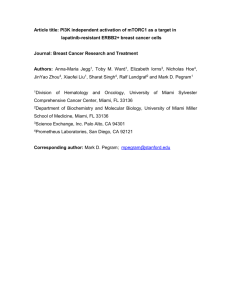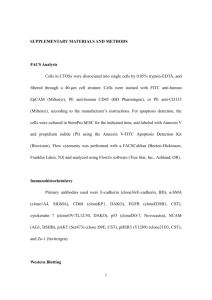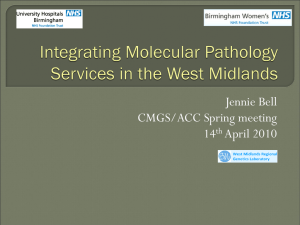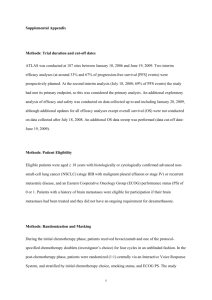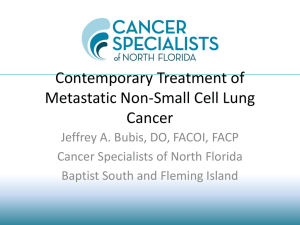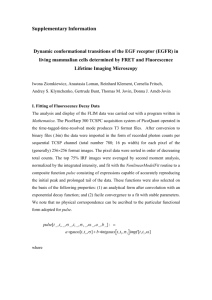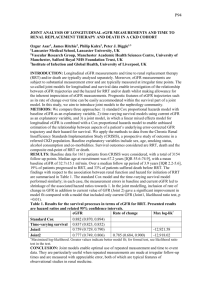EGFR in non small cell lung cancer
advertisement
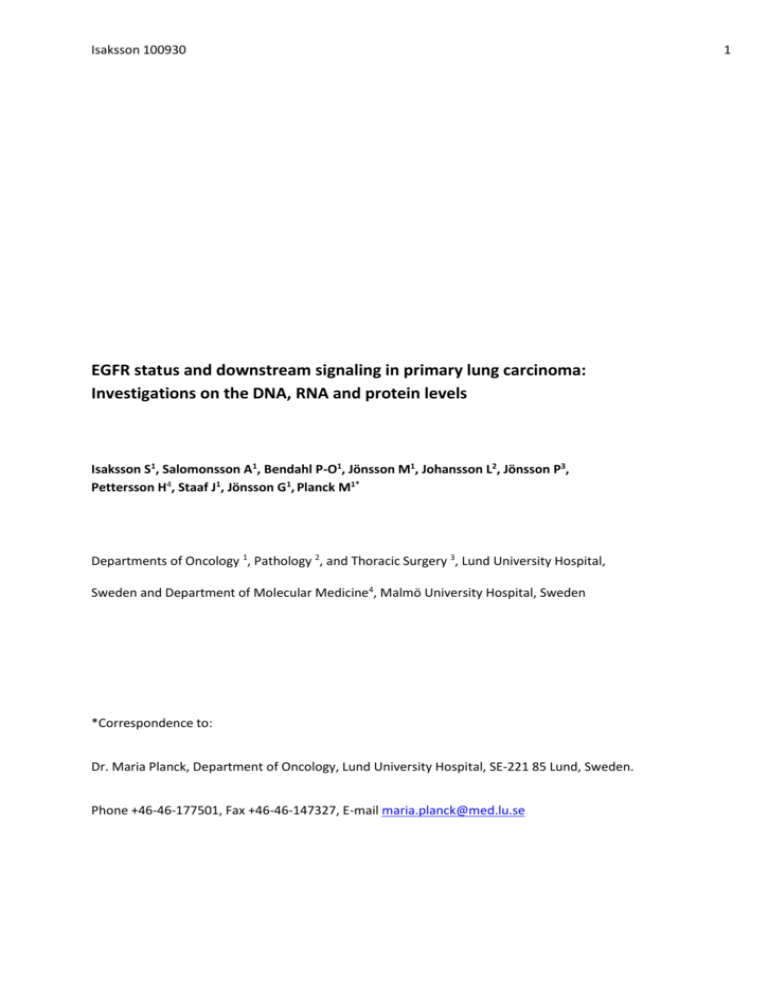
Isaksson 100930 EGFR status and downstream signaling in primary lung carcinoma: Investigations on the DNA, RNA and protein levels Isaksson S1, Salomonsson A1, Bendahl P-O1, Jönsson M1, Johansson L2, Jönsson P3, Pettersson H4, Staaf J1, Jönsson G1, Planck M1* Departments of Oncology 1, Pathology 2, and Thoracic Surgery 3, Lund University Hospital, Sweden and Department of Molecular Medicine4, Malmö University Hospital, Sweden *Correspondence to: Dr. Maria Planck, Department of Oncology, Lund University Hospital, SE-221 85 Lund, Sweden. Phone +46-46-177501, Fax +46-46-147327, E-mail maria.planck@med.lu.se 1 Isaksson 100930 2 Abstract Background: Lung carcinomas frequently exhibit complex karyotypes and mutation patterns, involving a large number of genes. The epidermal growth factor receptor (EGFR) pathway is targeted by recently developed therapies for advanced disease. This study focus on how various parameters of EGFR status correlate within the same primary lung tumors, differ between histological subtypes, and relate to involvement of other receptor tyrosine kinases (e.g. HER2 and KIT) or to patterns of downstream signaling (through the RAS and PI3K-AKT-PTEN pathways). Materials and Methods: Seventy-seven freshly frozen surgical specimens of primary NSCLCs (n=61) and SCLC (n=16) were collected. Occurrence of mutations was examined with direct DNA sequencing (EGFR, PIK3CA) or RT-PCR (KRAS). Gene amplifications / deletions were detected by quantitative real-time PCR (EGFR) or microarray based comparative genomic hybridization (32k BAC arrays). mRNA expression was investigated by RT-PCR (KIT) and microarray based gene expression analysis (Illumina). Paraffin-embedded material was used for construction of tissue microarrays and immunohistochemical analysis of expression of the EGFR, PTEN, P-AKT, KIT, HER2, ERK, and mTOR proteins. Results: In NSCLC, whereas 2 tumors were positive and 19 were negative for all three variables of EGFR status, 30 tumors exhibited positive protein expression alone, 5 were positive regarding gene amplification and protein expression but harbored no mutation, and 5 tumors were mutation positive but had neither amplification nor protein overexpression. In SCLC, positive EGFR protein expression was demonstrated in one and EGFR gene amplification in 3 tumors, all mutation negative. KRAS mutations were observed in adenocarcinomas alone, 14 tumors. Summary: In NSCLC, EGFR protein expression correlated with amplifications but was negative in the majority of tumors with mutation, thus further questioning the biological and clinical role for immunohistochemical determination of EGFR status. EGFR, as well as its downstream signaling through KRAS, were significantly less altered in SCLC compared to NSCLC (p=…and ….) whereas involvement of AKT and its inhibitor, PTEN, were comparable between all subtypes of lung carcinoma. KEYWORDS: LUNG CANCER , PIK3CA, KRAS NSCLC, SCLC, AMPLIFICATION, MUTATION, PROTEIN EXPRESSION , EGFR, PTEN, P-AKT, Isaksson 100930 3 INTRODUCTION Lung cancer, with high incidence and poor prognosis, is the leading cause of cancer related death, accounting for a third of all deaths from cancer worldwide1. Most lung cancer cases are classified as non-small cell lung cancer (NSCLC), with adenocarcinoma and squamous cell carcinoma being the frequent histological subtypes. Small cell lung cancer (SCLC) constitutes less than 20% of primary malignant lung tumors and, since very few cases are available for surgical resection, the tumor biology is less understood in SCLC compared to NSCLC. The development of targeted therapies directed against specific molecules involved in carcinogenesis has recently increased the treatment possibilities. One main target is the epidermal growth factor receptor (EGFR), inhibited by use of monoclonal antibodies or tyrosine kinase inhibitors2. The EGFR superfamily of transmembrane receptors includes EGFR/erbB-1, HER2/erbB-2, HER3/erbB-3 and HER4/erbB-4. Binding of ligand (epidermal growth factor (EGF), transforming growth factor-α (TGF-α), or neuregulins) to the extracellular domain results in homo-or heterodimerization, consequently initiating tyrosine kinase activity of the intracellular domains. Phosphorylated tyrosine residues then act as binding sites for signal transducers which in turn initiate downstream intracellular signalling cascades, involving for example the RAS-RAF and PI3K-AKT pathways, ultimately leading to carcinogenic events; cell proliferation, anti-apoptosis, metastasis and angiogenesis3. Lung tumorigenesis involves multiple genetic alterations and this complexity is challenging when evaluating clinical and biological markers as prognostic or predictive of response to treatment with targeted therapies. So far, non-smoking history, female sex, Asian ethnicity, adenocarcinoma, EGFR mutations, increased EGFR gene copy number, and wild-type K-RAS, are factors that have been associated with sensitivity to EGFR inhibitors4,5,6. We characterized primary early stage SCLC and NSCLC regarding EGFR gene copy numbers, occurrence of mutations in the tyrosine kinase domain of the EGFR gene, immunohistochemical expression of the EGFR protein, and occurrence of mutations in the downstream K-RAS gene. …pAKT PTEN PIK3CA!!!!!!!!!!!!!! Isaksson 100930 4 MATERIAL AND METHODS Patients and tumors Freshly frozen surgical specimens of primary lung carcinoma (62 NSCLCs and 16 SCLCs) were collected between 1989 and 2007 at the Lund University Hospital, Lund, Sweden. Clinical data were obtained from patient charts (Supplementary table 1); Of the 78 patients, 40 (51%) were women and 38 (49%) men. Sixty patients had a history of smoking, 11 patients (all NSCLC) were never-smokers, and data on smoking status was missing in 7 patients. Mean age at diagnosis was 66 years (range 37 -85 years). None of the patients had received preoperative chemo/radiotherapy. The tumors were reviewed by a pathologist and categorized as adenocarcinomas (48 tumors), squamous cell carcinomas (14 tumors) or SCLC (16 tumors). In one case, radicality could not be judged but all other tumors were evaluated as radically excised. Fifty-six tumors were staged as pT1-T2N0M0 according to the TNM classification (1996). In addition, the series included one T3, one T4, one M1 (satellite tumor in another lobe within the same lung), two N1 (bronchopulmonary ipsilateral) tumors, and one case of unknown N-status (Supplementary table 1). For 77 of the 78 cases the histopathological paraffin-embedded slides were available and the appropriate blocks could be identified for construction of TMAs; Two 1 mm tissue cylinders were collected from each tumor block and arranged in a recipient block using an electronic tissue arrayer (TMArrayer, Pathology Devices, Inc.USA). Microarray based CGH DNA for array-based CGH analysis was extracted from the 62 freshly frozen tumor specimens using Proteinase K (20mg/µl) digestion followed by phenol-chloroform purification according to published protocols. Isaksson 100930 5 Microarrays used for the present aCGH investigations were produced at the SCIBLU Genomics-facilities, Lund University, Sweden (http://www.lth.se/sciblu/services/dna_microarrays), using the 32k BAC Re-Array set Ver. 1.0 (BACPAC Resource Center, Children’s Hospital, Oakland Research Institute, US). This platform, including a total of 32 433 BAC clones, provides 99 % coverage of the BAC fingerprint map (November 2001) and comprises clones sampled from the RPCI-11, RPCI-13 (94%) and Caltech-D (6%) libraries. For all samples, 2µg of tumor DNA and 1.5µg reference DNA (Promega Corporation, Madison, USA) was labeled with Cy3-dCTP and Cy5-dCTP (Amersham Biosciences, Uppsala, Sweden), respectively, using BioPrime Array CGH Genomic Labeling System (Invitrogen Life Technologies, Carlsbad, US). Purification of labeled DNA was done using the Cyscribe GFX purification kit (Amershamn Biosciences) and the pooled tumor and reference DNA were mixed with Human COT-1 DNA (1µg/µl, Invitrogen Life Technologies) and resuspended in a hybridization buffer containing de-ionized formamide, Yeast-tRNA (Invitrogen Life Technologies) and dextrane sulphate. Array slides were UV cross-linked (500 mJ/cm2) and pre-treated using “Pronto! Universal Microarray Hybridization Kit” (Corning BV, Schiphol-Rijk, the Netherlands). Denatured and re-annealed DNA was applied to the arrays and hybridization was performed in hybridization chambers (Corning BV) for 48-72 hours in a 37°C water bath. Array slides were washed in post hybridization buffers with different contents of 20xSSC, 10% SDS and deionized formamide and scanned in an Agilent Microarray Scanner (Agilent Technologies, Palo Alto, CA). Spots were identified using GenePix Pro. 4.1 (Axon Instruments) and the data was uploaded in BioArray Software Environment (BASE) (Saal, et al. 2002). Background correction of the two channels was calculated using the median-feature and median-local background intensities of the uploaded file. A signal to noise ratio (SNR) was set to ≥ 5 for both channels and data was normalized using a pin-based lowess algorithm excluding chromosome X. A moving average of 250 kbp was applied to the CGH-plotter tool and plots were created excluding the X and Y chromosomes, and a noise constant was set to 25. Hierarchical cluster analysis was performed in BASE using Pearson correlation coefficient distance measure. Cutoffs for gain and amplification of the clones harboring the EGFR gene were set to log2 ratio 0.2 and 0.8, respectively. Isaksson 100930 6 Direct DNA Sequencing Mutations of exon 18 through 21 of the EGFR gene were analysed by direct DNA sequencing using the BigDye Terminator Cycle Sequencing Kit v1.1 (Applied Biosystems®). The samples were initially purified and subsequently amplified. PCR was performed in 10µL volumes using 80 ng (4µL 20ng/µL) template, 1, 75 µL 5xbuffer, 4 µL deionized water and 0, 5 µL Terminator reaction mix. The mutations in exons 18-21 were determined using primers described in supplementary table 1. PCR was run under the following conditions; 25 cycles of denaturation at 96°C for 10 s, primer annealing at 50°C for 5 s and elongation at 60°C for 1 min. Sequencing products were separated by capillary electrophoresis by ABI 3130xl Genetic Analyzer (Applied Biosystems®). Analysis of the sequence curves was performed using the 3100 data collection software (Gene Code Corporation®). To confirm the presence of sequence alterations, samples in which the studied sequences were found to be nonsynonymous with the wild type EGFR sequence were resequenced after a repeated extraction of DNA. Quantitative real time-PCR Quantitative real time-PCR was performed using Rotor Gene 3000 by Corbett Research and the binding dye iTaqTM SYBR® Green Supermix (BIO-RAD). To determine the copy number of the EGFR gene we used the genes for albumine and glucokinase as controls. The ratios were compared to similar ratios of control DNA. A standard curve for each run was constructed from serial dilutions. The CT-threshold was set to 0.2. Amplification mixes (20µL) contained 10 ng sample DNA, 10µL binding dye, 1µL primer and dH2O. Thermal cycling conditions comprised 10 min at 95°C and 45 cycles at 95°C for 15 s, 55°C at 30s and 72°C at 30 s. All the samples were analyzed in triplicate and the serial dilutions were performed in duplicates. Relative gene expression was calculated using the Pfaffl method (supplementary table 2). The ratios presented are average values of EGFR gene expression in relation to albumin and glucokinase. Ratio ≥ 1,5 signified amplification. Isaksson 100930 7 KRAS mutation analysis Mats – kan du komplettera? Reverse transcriptase PCR Annette – komplettera! Immunohistochemical analysis 3 µm sections were cut out from the TMA blocks and EGFR protein expression was evaluated immunohistochemically using the mouse monoclonal anti-human EGFR clone 2- antibody and the EGFR pharmDxTM kit (Dako) according to the manufactor’s instruction manual. The membrane staining was scored as 0 (negative) 1+ (weakly positive) 2+ (moderately positive) or 3+ (strongly positive) according to the EGFR pharmDx interpretation guidelines. When there was lack of agreement in IHC scoring between the two TMA cores from the same sample (Sofi – infoga detta! X/61 evaluable cases), the sample was scored according to the most positive core. All samples were independently evaluated by three of the authors (SI, MJ, MP) with an initial discrepancy in less than 2% of the judgments, and, after a consensus was achieved, these scorings were confirmed by a pathologist (LJ). Statistics Pär-Ola ? RESULTS Seven of the NSCLC tumors (11%) harbored EGFR mutations, all summarized in table 2. Only two samples were positive for both EGFR mutation and EGFR amplification (Tables 1 and 2) and there was thus no statistically significant correlation between mutations and amplifications of the EGFR gene (p=0,18). Isaksson 100930 8 61 of the NSCLC were available for analysis of EGFR protein expression (Table 4, fig 1). There was an association between amplification and 3+ IHC staining of the tumors (p<0.001) although the two samples with simultaneous EGFR amplification and mutation (table 3), were classified as 1+. Tumors with mutated but not amplified EGFR (n=5) were classified as 0 (Table 4). Thus, in the IHC positive group (constituting 37/61 tumors) the EGFR mutation frequency was 5% whereas 21% of the tumors in the IHC negative group (a total of 24 out of 61 evaluable tumors) harboured EGFR mutations. KRAS mutations were analyzed with RT-PCR. Of the 62 samples, 48 (77%) were wild type and 14 (23%) were mutated (Table 3). KRAS and EGFR mutations were mutually exclusive. KRAS amplifications were identified with aCGH in 5 (8%) of the tumors (Table 3). Discussion All major histological types of invasive lung carcinoma frequently exhibit molecular alterations that involve a large number of genes, thus believed to have accumulated during a multistep carcinogenesis 7. To identify the key molecules among multiple genetic alterations and to subsequently apply this knowledge on the development of targeted therapies has therefore become a prioritized challenge in the fight against this devastating disease. One validated target for lung cancer therapy is the EGFR pathway. EGFR is widely expressed in lung cancer and has well-documented oncogenic activity through regulation of proliferation, invasion, angiogenesis, and apoptosis8,9. We characterized early stage primary NSCLCs regarding alterations of the EGFR pathway (EGFR copy numbers, mutations of the EGFR and KRAS genes, and immunohistochemical staining of the EGFR protein). We showed an absolute correlation between high amplification of EGFR as revealed by aCGH and increased number of EGFR copies detected by qPCR (Table 1). Quantitative RT-PCR is thus reliable for validation of aCGHfindings. Somatic EGFR mutations were found in 11% of the tumors. In line with previous data, all mutation positive cases were adenocarcinomas and female patients were overrepresented (Table 2)10. We detected two Isaksson 100930 9 insertions in exon 20 and one substitution in exon 21 although, as expected from previous studies, the most common mutations were 15 /18 bp in-frame deletions in exon 19, proven as predictive markers for response to EGFR inhibitors by several reports5,11,12. Whereas strongly positive IHC correlated with EGFR amplifications, IHC turned out negative in the majority of tumors with EGFR mutation in our study (Table 4). Our results thus further question the clinical use of IHC for determination of EGFR status. Similar results can be found in previous reports demonstrating negative IHC EGFR expression for about 40% of mutation positive tumors with unknown EGFR copy numbers13,14. The two tumors with concomitant amplification and mutation of EGFR were classified as IHC 1+, pointing towards a mechanism which results in lower IHC scoring when EGFR mutations are present in tumors with increased EGFR gene copy numbers. Indeed, results from studies of mutant to wt allele ratios in lung tumors with simultaneous EGFR copy gain and EGFR mutation, indicate that the mutant allele is selectively gained15. Of the 30 tumors in our series which were IHC positive without any revealed amplification or gain in the EGFR region, only 3 were strongly stained, i.e. 3+. These tumors were all SqCC, perhaps suggesting that this histological subtype might harbor mechanisms other than gene amplification that influence protein expression. The high impact of alterations in EGFR and its downstream molecules on lung tumorigenesis is well described, but how these different mechanisms of oncogenic activation interact within the very same tumors is less frequently investigated. In total, we found KRAS mutations in 14 tumors (23%). Consistent with previous reports, all patients were smokers or former smokers (Massarelli et al) and this was also true for patients whose tumors demonstrated KRAS amplifications by aCGH in our study (5/62 tumors, table 3). In our material, EGFR mutations and KRAS mutations were mutually exclusive as described in previous studies16 17. However, EGFR amplifications and high level amplification of the 12p12.1 locus, containing KRAS (as revealed by aCGH) were, in contrast, not mutually exclusive. Recurrent copy gains of the KRAS locus, demonstrated also in genome wide studies by others, indicate functional significance of these copy number alterations18 (ref Weir et al. Nature 2007). Furthermore, an association between activating KRAS mutations and KRAS copy number Isaksson 100930 10 gain/amplification has been reported, suggesting that these gains undergo a positive selection, which is stronger in mutant tumors, thus consistent with previous data on mutant to wt allele ratios of the EGFR gene (ref Modrek et al. Molecular Cancer Research 2009 and Barmak Modrek). A relatively small overlap between mutation and amplification was seen for KRAS (2 samples) and EGFR (2 samples) in our study. A possible explanation for this could be that also wild-type alleles can act as tumor promoters if a selection pressure in individual tumors modulates the copy numbers. As mentioned above, EGFR mutations and EGFR amplifications in lung carcinoma are suggested as predictive for positive outcome after treatment with EGFR inhibitors10,11. In our study, EGFR mutations and gene amplifications affected the whole genome copy number profiles of the tumors in an unsupervised cluster analysis of aCGH data. These correlations possibly reflect the importance of the EGFR pathway in NSCLC tumorigenesis (Fig ). In light of this, one might postulate that the IHC patterns, with no correlation at all to aCGH profiles, are less likely to mirror the true EGFR-related biology of the tumors (Fig ). In conclusion, although high immunohistochemical EGFR expression was seen in tumors with amplification of the EGFR gene, the consequent lack of expression in tumors with EGFR mutation again demonstrates the limitations of EGFR immunohistochemistry as clinical predictor in lung cancer. Furthermore, and most importantly, we postulate the existence of whole genome copy number profiles with respect to EGFR status (amplification/mutation), thus again emphasizing the importance of this tumorigenic pathway in lung cancer development. However, there is a need for confirming studies that correlate these and other biomarkers (e.g. occurrence of extra EGFR gene copies, different EGFR mutation subtypes, KRAS mutations, MET amplification, Akt overexpression, or LKB1 mutations) to distinct whole genome copy number profiles, and also to gene expression and proteomic patterns. Isaksson 100930 11 References 1. Jemal A, Siegel R, Ward E, Hao Y, Xu J, Thun MJ. Cancer Statistics, 2009.CA: A Cancer Journal for Clinicians 2009;59;225-249 2 Katzel JA, Fanucchi MP, Li Z. REVIEW Recent advances of novel targeted therapy in non-small cell lung cancer. Journal of Hematology & Oncology2009; 2:2 3 Scagliotti GV, Selvaggi G, Novello S, Hirsch FR. The Biology of Epidermal Growth Factor Receptor in Lung Cancer. Clinical Cancer Research 2004; 10, 4227s–4232s 4 Which biomarker predicts benefit from EGFR-TKI treatment for patients with lung cancer? Uramoto 5 Epidermal growth factor receptor mutations in lung cancer. Sharma et al. Nature reviews 2007. 6 Understanding the ew enetics of responsiveness to epidermal growh factor receptor to tyrosine kinase inhibitors. Toschi L. et al. The oncologist 2007. 7 Mitelman F, Johansson B, and Mertens F. Mitelman Database of Chromosome Aberrations in Cancer (2009). http://cgap.nci.nih.gov/Chromosomes/Mitelman 8 Araújo A, Ribbeiro R, Azevedo I, Coelho A, Soares M, Sousa B et al.Genetic Polymorphisms of the Epidermal Growth Factor and Related Receptor in Non-Small Cell Lung Cancer-A review of the Literature. The Oncologist 2007; 12:201-210 9 Herbst RS, Heymach JV, Lippman SM. Molecular Origins of Lung Cancer. The New England Journal of Medicine 2008;359:1367-80 10 Mitsudomi T, Kosaka T, Yatabe Y. Biological and clinical implications of EGFR mutations in lung cancer Isaksson 100930 11 Riely GJ, Pao W et al. Clinical Course of Patients with Non -Small Cell Lung Cancer and Epidermal Growth Factor Receptor Exon19 and Exon 21 Mutations Treated with Gefitinib or Erlotinib. Clin Cancer Res 2006;839 12(3) 12 Jackman DM, Yeap BY, Sequist LV, Lindeman N, Holmes AJ et al.Exon 19 Deletion Mutations of Epidermal Growth Factor Receptor Are Associated with Prolonged Survival in Non-Small Cell Lung Cancer Lung Cancer PatientsTreated with Gefitinib or Erlotinib. Clin Cancer Res 2006;12(13) 13 Reinmuth 2008 Correlation of EGFR mutations with chromosomal alterations and expression of EGFR, ErbB3 and VEGF in tumor samples of lung adenocarcinoma patients. 14 El-Zammar 2009 Comparison of FISH, PCR, and immunohistochemistry in assessing EGFR status in lung adenocarcinoma and correlation with clinicopathologic features. 15 Takano T, Ohe Y, Sakamoto H et al Epidermal growth factor receptor gene mutations and increased copy numbers predict gefitinib sensitivity in patients with recurrent non-small-cell lung cancer. J Clin Oncol 2005;23:6829–37. 16 KRAS mutation is an important predictor of resistance to therapy with epidermal growth factor receptor tyrosine kinase inhibitors in non-small cell lung cancer. 2007. Erminia Massarelli 17 Mutations of the epidermal growth factor receptor gene and related genes as determinants of epidermal growth factor receptor tyrosine kinase inhibitors sensitivity in lung cancer 12 Isaksson 100930 13 18 -> 17 Barmak Modrek, Lin Ge, Ajay Pandita et al. Oncogenic Activating Mutations Are Associated with Local Copy Gain. Mol Cancer Res 2009;7(8): 1244-52
